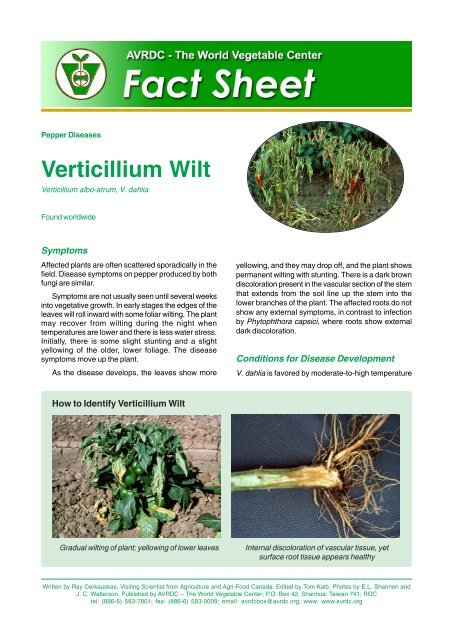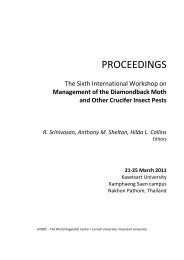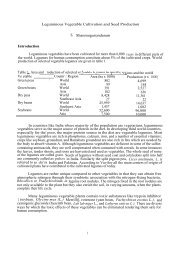Verticillium Wilt on Pepper
Verticillium Wilt on Pepper
Verticillium Wilt on Pepper
Create successful ePaper yourself
Turn your PDF publications into a flip-book with our unique Google optimized e-Paper software.
<strong>Pepper</strong> Diseases<str<strong>on</strong>g>Verticillium</str<strong>on</strong>g> <str<strong>on</strong>g>Wilt</str<strong>on</strong>g><str<strong>on</strong>g>Verticillium</str<strong>on</strong>g> albo-atrum, V. dahliaFound worldwideSymptomsAffected plants are often scattered sporadically in thefield. Disease symptoms <strong>on</strong> pepper produced by bothfungi are similar.Symptoms are not usually seen until several weeksinto vegetative growth. In early stages the edges of theleaves will roll inward with some foliar wilting. The plantmay recover from wilting during the night whentemperatures are lower and there is less water stress.Initially, there is some slight stunting and a slightyellowing of the older, lower foliage. The diseasesymptoms move up the plant.As the disease develops, the leaves show moreWorld Vegetable Centeryellowing, and they may drop off, and the plant showspermanent wilting with stunting. There is a dark browndiscolorati<strong>on</strong> present in the vascular secti<strong>on</strong> of the stemthat extends from the soil line up the stem into thelower branches of the plant. The affected roots do notshow any external symptoms, in c<strong>on</strong>trast to infecti<strong>on</strong>by Phytophthora capsici, where roots show externaldark discolorati<strong>on</strong>.C<strong>on</strong>diti<strong>on</strong>s for Disease DevelopmentV. dahlia is favored by moderate-to-high temperatureHow to Identify <str<strong>on</strong>g>Verticillium</str<strong>on</strong>g> <str<strong>on</strong>g>Wilt</str<strong>on</strong>g>Gradual wilting of plant; yellowing of lower leavesInternal discolorati<strong>on</strong> of vascular tissue, yetsurface root tissue appears healthyWritten by Ray Cerkauskas, Visiting Scientist from Agriculture and Agri-Food Canada. Edited by Tom Kalb. Photos by E.L. Shann<strong>on</strong> andJ. C. Watters<strong>on</strong>. Published by AVRDC – The World Vegetable Center; P.O. Box 42, Shanhua; Taiwan 741; ROCtel: (886-6) 583-7801; fax: (886-6) 583-0009; email: avrdcbox@avrdc.org; www: www.avrdc.org
while V. albo-atrum is favored by cooler temperature.Both fungi survive in soil and crop debris as specializedstructures called microsclerotia. These structuresenable the fungus to tolerate extreme envir<strong>on</strong>mentalc<strong>on</strong>diti<strong>on</strong>s and lie dormant in the soil for many years inthe absence of a susceptible host. In the presence ofmoisture, root exudates of susceptible plantsstimulate the germinati<strong>on</strong> of microsclerotia.The fungus directly penetrates the roots and movesthrough the root tissue to the water-c<strong>on</strong>ducting vessels.These become plugged with the fungus, causing plantsto wilt.The fungus is disseminated with infected transplants,irrigati<strong>on</strong> water, wind, <strong>on</strong> particles of infested soil <strong>on</strong>farm implements, machinery, vehicles, and <strong>on</strong> workershoes.Attack of pepper roots by nematodes will hasten<str<strong>on</strong>g>Verticillium</str<strong>on</strong>g> wilt development.C<strong>on</strong>trolSanitati<strong>on</strong> is crucial since <strong>on</strong>ce the fungus is introducedinto the field it may remain indefinitely. If possible, wherelimited infecti<strong>on</strong> occurs, destroy infested plant material(including root tissue) after harvest to reduce populati<strong>on</strong>sof the fungus. Eliminate weeds in the producti<strong>on</strong> fieldthat may serve as symptomless hosts for the fungusor other susceptible crops that may c<strong>on</strong>tribute tobridging the period between susceptible pepper crops.Clean farm utensils and equipment when moving from<strong>on</strong>e field to another. Wash the soles of shoes afterworking in an infested area. Work in healthy fields firstbefore working in affected fields.For transplant producti<strong>on</strong>, use disease-freetransplants, pasteurized soil medium, or fumigatedplant beds. Use proper sanitati<strong>on</strong> measures fortransplant producti<strong>on</strong>, and avoid damage to roots duringtransplanting. Treat surfaces with a disinfectant beforeplacing flats there.Temporary flooding will reduce populati<strong>on</strong>s ofmicrosclerotia. Do not irrigate a field with waterc<strong>on</strong>taining runoff from other affected fields.Use a l<strong>on</strong>g rotati<strong>on</strong> of 3–4 years, including rice,broccoli, corn or sorghum, to allow plant residues todecompose in the soil and to reduce fungal populati<strong>on</strong>sin the soil. Avoid use of tomatoes, potatoes, eggplant,or strawberries in the rotati<strong>on</strong> scheme.Pre-plant soil solarizati<strong>on</strong> al<strong>on</strong>e or combined withfumigati<strong>on</strong>, especially using fumigants c<strong>on</strong>tainingchloropicrin, will reduce fungal populati<strong>on</strong>s. This isespecially effective in nethouse, greenhouse or rainshelter producti<strong>on</strong>. Maintain a high level of plant vigorwith appropriate fertilizati<strong>on</strong> and irrigati<strong>on</strong> to keep plantsless susceptible.Avoid c<strong>on</strong>taminated land. Keep seedling and cropproducti<strong>on</strong> fields away from previous fields infested with<str<strong>on</strong>g>Verticillium</str<strong>on</strong>g>.Resistant pepper cultivars are not available.C<strong>on</strong>trol root-knot nematodes and root-feedinginsects since they may help <str<strong>on</strong>g>Verticillium</str<strong>on</strong>g> to establishand spread.For more informati<strong>on</strong> <strong>on</strong> the producti<strong>on</strong> ofpepper and other vegetables, go to.AVRDC Publicati<strong>on</strong> 04-5812004
















